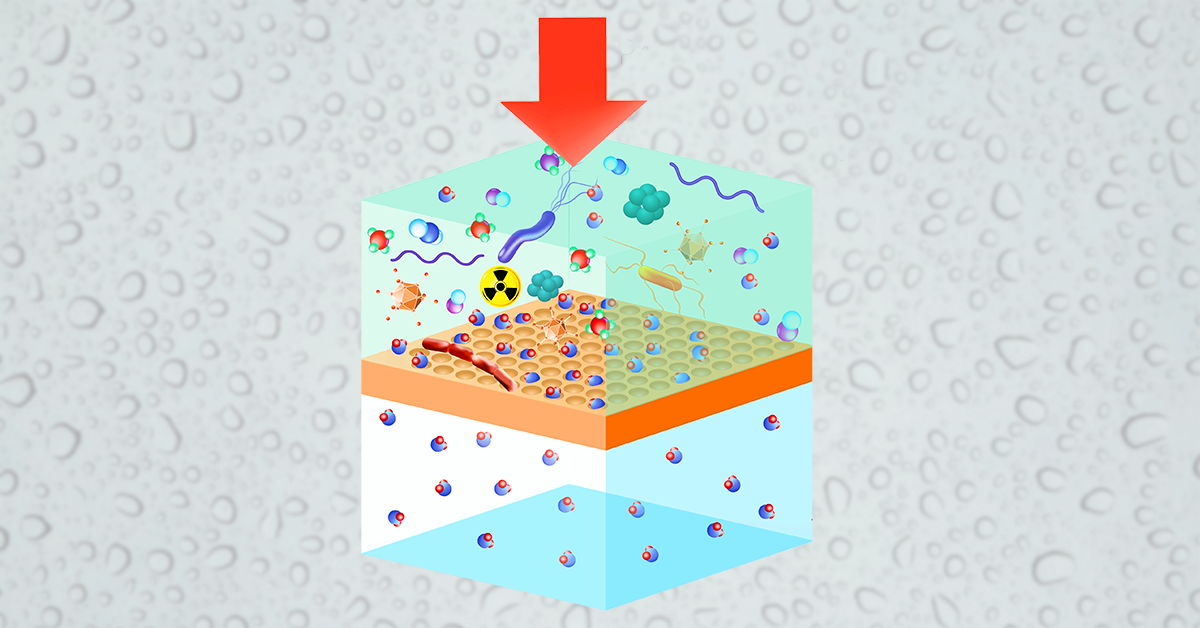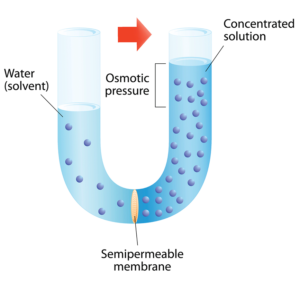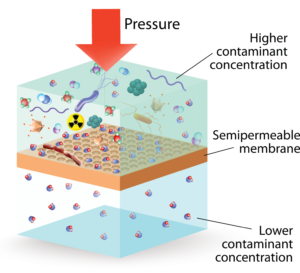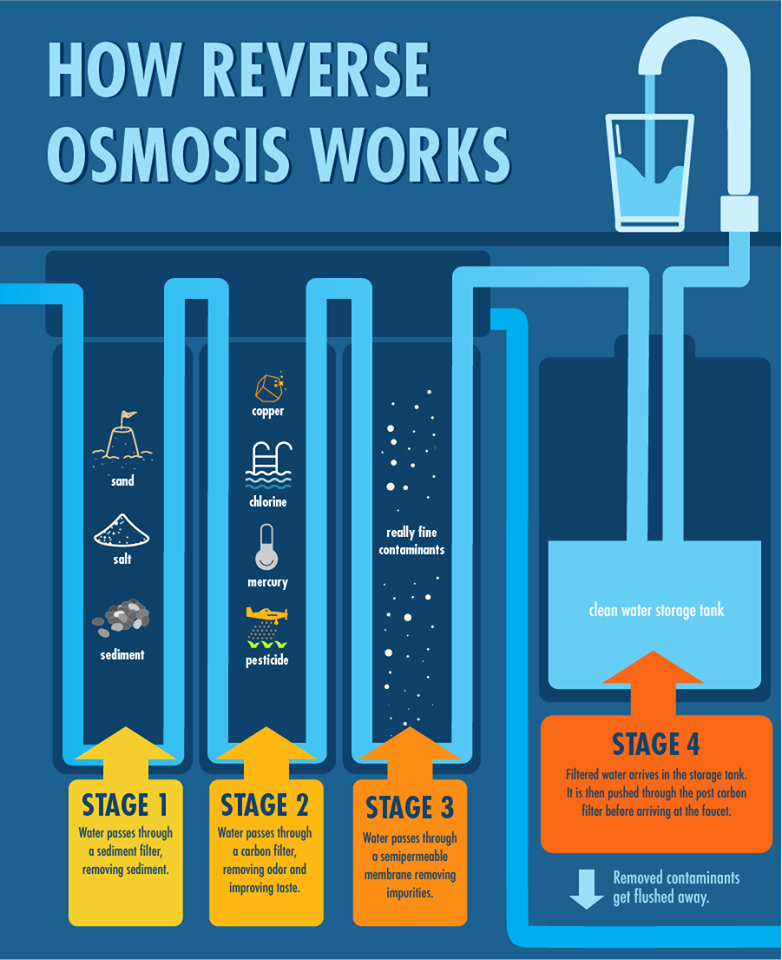Reverse Osmosis Filtration - How Does It Really Work?
The first step to better drinking water is learning how reverse osmosis works.
Posted in
Bad Tasting Water,
Culligan Nation,
Drinking Water,
Drinking Water System,
Filtration,
Reverse Osmosis

Whether your drinking water comes from a well or municipal supply, it's possible that harmful contaminants are present. Reverse osmosis is a great filtration method to choose when it comes to protecting your home and family.
So, let's learn more. How does reverse osmosis really work?
What is Osmosis?
 The key to understanding reverse osmosis is first understanding the process of osmosis.
The key to understanding reverse osmosis is first understanding the process of osmosis.Osmosis is defined as the passage of a solvent, such as water, from a lower-concentration solution to a higher-concentration solution. A semipermeable membrane separating the two solutions allows the solvent to pass. But not what is dissolved in it.
The flow finally stops when both solutions become equal in concentration. This process is classified as passive transport. Because it does not require energy to be applied.
So What Is Reverse Osmosis Then?
Unlike osmosis, reverse osmosis requires an external force to complete the transport. Therefore, pressure is a key part of the reverse osmosis process.

And like its name implies, reverse osmosis is the opposite of osmosis. Instead of balancing out the two solutions, the external force of pressure reverses the natural flow.
Since contaminant molecules are larger than water molecules, only water pushes through the semipermeable membrane.
Applying more pressure to the contaminated water makes the reverse osmosis process more effective.
What Are the Steps Of Reverse Osmosis Filtration?
When thinking about this process, it's helpful to break it down into four distinct steps.
Different brands might vary slightly. But in general, all reverse osmosis systems perform pre-filtration, reverse osmosis, drainage and storage.
Let's expand on that.
First, pressurized water goes through a particle filter to remove impurities like salt, sand and sediment.
Next the water passes through an activated carbon filter that traps and removes minerals and contaminants such as chlorine, mercury, copper and pesticides. These first two phases are considered the pre-filtration stage.
After pre-filtration, pressurized water is forced through the semipermeable membrane. The smallest impurities become trapped and only water passes through. This is the reverse osmosis stage.
To give you an idea of the membrane's power, the diameter of one human hair is about 100 microns wide. But in Culligan RO Systems, the spaces in the membrane are approximately ONE micron wide.
Finally, the removed contaminants flush away in the discharge stage. While the treated water moves to a storage tank.
Before the treated water reaches a faucet, it undergoes a final activated-carbon filtration to improve taste and quality for household use.
What Does Reverse Osmosis Remove*?
Few filtration systems remove all contaminants. But reverse osmosis can significantly reduce some of the most dangerous impurities. So what does reverse osmosis actually remove?
Lead
There is no safe level of lead exposure, especially for children. And the contaminant cannot be seen, smelled or tasted. So the only way to know whether lead is in your water is to test for it.
Mercury
Mercury found in water comes from the natural degassing of the earth's crust and from human activities such as burning fossil fuels. Too much mercury in the body damages the brain, kidneys, or even a developing fetus.
Chromium-6
Chromium-6 is also known as hexavalent chromium. And it's an industrial chemical that found in the drinking water of all 50 states. Chromium-6 is a known carcinogen, linked to cancer, reproductive issues, asthma attacks and other severe effects.
Chlorine
While aesthetics are not necessarily health-related, they affect the taste and odor of your water. If you don't want your water tasting or smelling like chlorine, an RO can take care of that.
Chloramine
Chloramines are a derivative of ammonia and contribute to an altered taste or smell in your drinking water.
Sediment
Cloudiness or haziness in water can be caused by high sediment levels. The higher the sediment level in drinking water, the greater chance consumers have of developing gastrointestinal diseases.
Over 90 Additional Contaminants
A Culligan Reverse Osmosis drinking water system is certified to reduce every EPA-regulated contaminant. More than 100 in total. In comparison to other popular at-home filtration methods, its power is second to none.
How Does Reverse Osmosis Compare to Other Filtration Methods?
So now that we know the reverse osmosis process, it's worth looking at how it stacks up to other filtration methods.
Other popular filter options include refrigerator filters, faucet filters and pitcher filters. While all can help you with taste and smell, few will reduce the most dangerous and invisible contaminants.
However, a RO system can efficiently remove contaminants that others may miss.
Plus, many refrigerator, faucet and pitcher filters require ongoing maintenance for maximum performance. RO units do not.
They can take care of your filtration needs consistently, for a good number of years. And without compromising on the taste and quality of your water.
How Do You Get Reverse Osmosis For Your Home?
Giving your people better water can be easy. All it takes is one phone call to your local Culligan water expert.
Culligan knows that water quality can vary greatly depending on location. Your local dealership is made up of a professional and knowledgeable team of water experts to help you along the way.
We offer many different drinking water systems with RO filtration. Such as the Aquasential® Reverse Osmosis Drinking Water Filtration System, AC-30 Good Water Machine® Drinking Water Filter System and Bottle-Free® Coolers.
One size does not fit all when it comes to water problems. So it's our standard practice to recommend a solution that is tailored to your family, home and lifestyle.

*Contaminants may not be in your water. Culligan reverse osmosis systems can reduce contaminants by up to 99.9%

